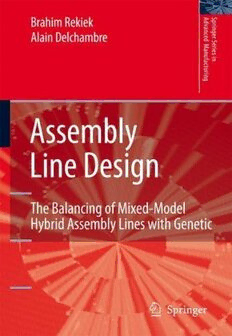
Assembly Line Design: The Balancing of Mixed-Model Hybrid Assembly Lines with Genetic Algorithms PDF
176 Pages·2005·2.309 MB·English
Most books are stored in the elastic cloud where traffic is expensive. For this reason, we have a limit on daily download.
Preview Assembly Line Design: The Balancing of Mixed-Model Hybrid Assembly Lines with Genetic Algorithms
Description:
Efficient assembly line design is a problem of considerable industrial importance. Unfortunately, like many other design processes, it can be time-consuming and repetitive. In addition to this, assembly line design is often complex owing to the number of multiple components involved: line efficiency, cost, reliability and space for example. The main objective is to integrate the design with operations issues, thereby minimising its costs. Since it is impossible to replace a designer’s intelligence, experience and creativity, it is important to provide him with a set of assistance tools in order to meet the conflicting objectives involved. Assembly Line Design presents three techniques based on the Grouping Genetic Algorithm (a powerful and broadly applicable optimisation and stochastic search technique) which can be used to aid efficient assembly line design: • вЂequal piles for assembly lines’, a new algorithm introduced to deal with assembly line balancing (balancing stations’ loads); • a new method based on a multiple objective grouping genetic algorithm (MO-GGA) aiming to deal with resource planning (selection of equipment to carry out assembly tasks); вЂвЂў balance for operation’ (BFO), introduced to deal with the changes during the operation phase of assembly lines. Assembly Line Design will be of interest to technical personnel working in design, planning and production departments in industry as well as managers in industry who want to learn more about concurrent engineering. This book will also be of value to researchers and postgraduate students in mechanical, manufacturing or micro-engineering.
See more
The list of books you might like
Most books are stored in the elastic cloud where traffic is expensive. For this reason, we have a limit on daily download.
